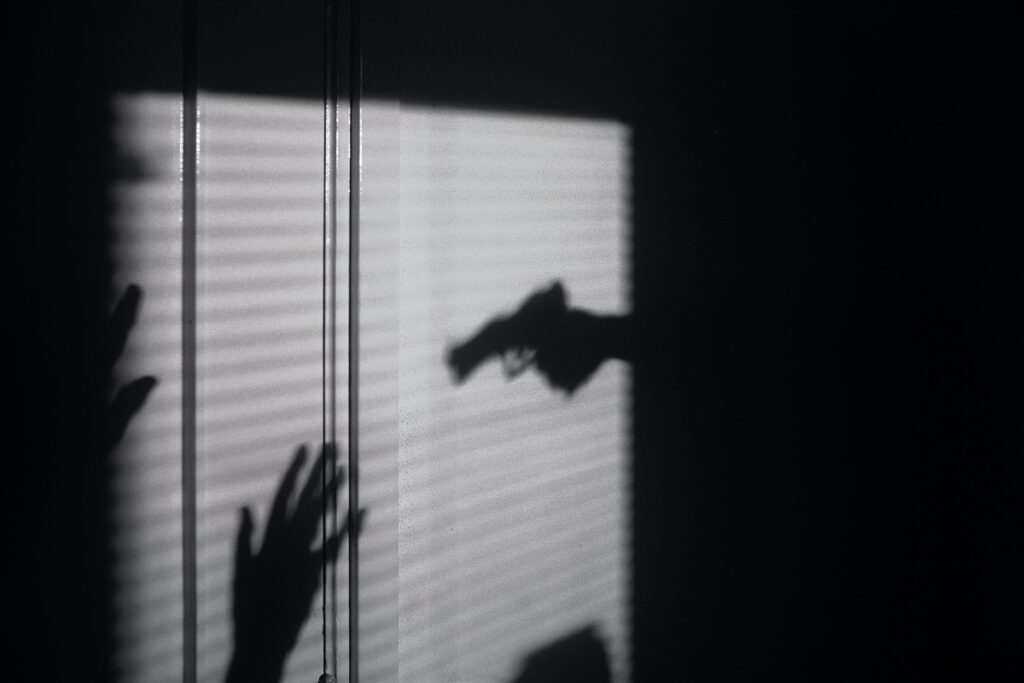
An Odd Preoccupation in the True Crime Genre with Rural, Red-State Crimes and Scandals Props Up Narratives that Marginalize Inland Regions of the U.S., Likely with Political Motivations
In American entertainment, people who dwell in rural parts of the country’s interior are generally caricatured as narrow-minded, incurious, hostile to outsiders and often dangerous. In entertainment, there has been a surge and reinvention of the true crime genre in the last decade. And over the last few years, there’s a puzzling eagerness to create content about true crime in—usually conservative—rural places.
An example of the show-business takes on rural America is the famous “very cosmopolitan” scene from the ‘80s movie Tombstone. Cowboys Wyatt Earp and associates talk near the city’s main thoroughfare with a sheriff. Their conversation is a back-and-forth on how sophisticated their growing rural Arizona mining town is becoming. The talk is quickly interrupted by two arguing men who tumble out of a saloon midway through a gunfight. “Very cosmopolitan,” says Doc Holiday, sarcastically remarking on just how civilized and urbane the town looks.
And Tombstone was itself, a true crime story.
Yet, at the start of 2023, that type of violent crime is more of a daily occurrence in large cities like New York and L.A. It’s less prevalent in the rural Southwest. Despite this unraveling of urban centers in the 2020s, true crime stories—particularly over the last few years—have zeroed in on gothic episodes from the nation’s interior. And these true crime or historical fiction stories often have exaggerated tones and thinly veiled contempt. If it’s not a true crime documentary, it’s historical fiction with an almost transparent narrativizing of the rural people involved.
Recent Examples of True Crime Content Focusing on Inland and Rural Places
Harold Henthorn, the Denver man convicted of killing his second wife, was the debut topic of HULU’s Wild Crimes which debuted in 2021. The series is ostensibly about law enforcement who focus on crimes committed in national parks.
Throughout the first episode of this premiere season, the narrative sets in that these look like down-home, decent people—on the surface. The episode also says that the couple met on a Christian dating site. Harold Henthorn, a professional philanthropy coordinator, helped hospitals and churches raise money. The church’s part is mentioned more than once.
There’s always the retort that creative decisions by the storyteller are just part of the dramatic effect of entertainment. There’s no proof of prejudice. However, the repeated emphases on church life, the Christian dating site detail and the critical add-on about church fundraising are hard to miss. There’s a clear pattern in what details the show highlights.
But it’s not just Colorado tragedies that get outsized attention from Hollywood.
Sudden Burst in Fascination with Crime in the Red States
Texas True Crime (HULU & Lone Wolf, 2021), season 1, episode 2 is about homeschooler-mom and Evangelical Christian Andrea Yates. The woman who drowned her six children. Another series, Southern Gothic (Investigation Discovery, 2020), apparently covers only murders in the “unique settings, and boundless mystery” of the South.
Gone South (Cadence 13, 2021) is a podcast that premieres with a recounting of the 1987 Louisiana murder of a one-time prosecutor. From this murder, the journalism-award-winning podcast spins into conjecture that there is a large, underground criminal organism in the South called the “Dixie Mafia.” It’s unclear if the podcast mentions that New Orleans was known for massive endemic crime and corruption for decades. It was so bad that New Orleans was an outlier for crime and corruption for the entire nation. Both those things easily tilt the batting average for crime in the South and specifically Louisiana.
The closer examination does not show a ruthless, determined crime syndicate. The Dixie Mafia looks like more of a hodgepodge group of subregional tribes with one-off corrupt local officials and two-bit hustlers. One such hustler is their “enigmatic ringleader,” Kirksey Nix.
Unsurprisingly, this semi-fictional, supposed criminal enterprise shows up in the Evangelical-bashing quasi-historical-fiction series Righteous Gemstones.
Historical Fiction
The Righteous Gemstones suggests another historical fiction hobbyhorse for blue-county thinkers and entertainers: religion. Historical events with any proximity to confessional Christianity are a gold mine for many in documentary entertainment. Overdone stories involving Evangelical, conservative denominational or devout Catholic faith have obvious embellishments with the effect of caricaturing the people involved.
And in terms of religion, historical, confessional Christianity and Evangelicalism are more common apart from the coasts—hence “The Bible Belt.” All this means that real-life scandals like those of Jimmy Swaggart and Jim Bakker were just too much for the thinking man’s Hollywood to resist.
In that style of revisionist historical fiction, Righteous Gemstones (HBO, 2019), takes a swipe at TV preachers and their scandals. It’s a fictional series about a televangelist dynasty. Predictably, the show is set in a vague South Carolina location, Southern accents included.
There is also The Way Down: God, Greed and the Cult of Gwen Shamblin (HBO MAX, 2021) about a Christian weight-loss leader from Tennessee who made videos and teachings on religious life and on losing weight. That teacher, Gwen Shamblin Lara, even had the stereotypical southern beehive hair swoop. The Way Down presents, in fictionalized setting, the improprieties and cultish behaviors of her and her church.
The Added Complication of Documentaries, True Crime and Reality TV
Gone South, The Way Down, Southern Gothic and Wild Crimes highlight a new angle in entertainment. TV and radio serials are no longer just fictional caricatures by urban elites. Documentary-based “infotainment” creates a form of entertainment that appears to require evidence. Evidence-based amusement of this sort could be called misentertainment.
Entertainment is now much less about showing ideals – romance, justice, human motivations, sacrifice, good, and evil – in fiction. Examples of that fiction would be drama or relatable mockery: police formulas for the former and sitcoms for the latter. Also, reality TV and documentaries are much cheaper than scripted shows with A and B-list actors who can command 7-figure salaries. With subscription streaming services cutting into advertising money, infotainment is also lucrative.
For these and other reasons, entertainment in the 21st century is often an attempt to present some part of reality instead of a distraction. This new documentary-style entertainment is nothing if not suspicious. Within the last few years, in the entertainment generally considered a true crime, the impression given by these arts and entertainment is a narrative–or deliberate counter-narrative–about the South, the Southwest and Midwest.
Beyond National Politics, Reasons for Focusing on Rural American Towns are Unclear
Of course, there’s no straight line between politics and showbiz, but the leftwing, urban-minded bend in entertainment is now evident beyond a reasonable doubt.
After 2016, the news media led an effort to find the original sin in the Heartland that led to Donald Trump’s election. If their quest trickled down into entertainment, that might explain the recent explosion in bizarre true crime TV shows or entertainment that ridicule the South, the Southwest and Midwest. With this, we see the usual disabling preoccupation with politics and the disapproval of the majority red-state interior regions of the U.S.
Whatever the reasons, it’s hard not to see a pattern of true crime series increasingly and consistently preoccupied with inland, rural crimes. The rise in documentary, reality TV and infotainment amusement appears to be trying to harden these narratives. Underneath (and sometimes out in the open) these entertainments look political. And the concentration on rural, inland America looks deliberate. And it’s increasing.









